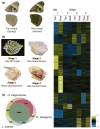Extensive transcriptional response associated with seasonal plasticity of butterfly wing patterns
- PMID: 25369871
- PMCID: PMC4545284
- DOI: 10.1111/mec.12988
Extensive transcriptional response associated with seasonal plasticity of butterfly wing patterns
Abstract
In the eastern United States, the buckeye butterfly, Junonia coenia, shows seasonal wing colour plasticity where adults emerging in the spring are tan, while those emerging in the autumn are dark red. This variation can be artificially induced in laboratory colonies, thus making J. coenia a useful model system to examine the mechanistic basis of plasticity. To better understand the developmental basis of seasonal plasticity, we used RNA-seq to quantify transcription profiles associated with development of alternative seasonal wing morphs. Depending on the developmental stage, between 547 and 1420 transfrags were significantly differentially expressed between morphs. These extensive differences in gene expression stand in contrast to the much smaller numbers of differentially expressed transcripts identified in previous studies of genetic wing pattern variation in other species and suggest that environmentally induced phenotypic shifts arise from very broad systemic processes. Analyses of candidate endocrine and pigmentation transcripts revealed notable genes upregulated in the red morph, including several ecdysone-associated genes, and cinnabar, an ommochrome pigmentation gene implicated in colour pattern variation in other butterflies. We also found multiple melanin-related transcripts strongly upregulated in the red morph, including tan and yellow-family genes, leading us to speculate that dark red pigmentation in autumn J. coenia may involve nonommochrome pigments. While we identified several endocrine and pigmentation genes as obvious candidates for seasonal colour morph differentiation, we speculate that the majority of observed expression differences were due to thermal stress response. The buckeye transcriptome provides a basis for further developmental studies of phenotypic plasticity.
Keywords: Junonia coenia; ecdysone; ommochrome; phenotypic plasticity; polyphenism; transcriptome; wing patterns.
© 2014 John Wiley & Sons Ltd.
Figures




Similar articles
-
Transcriptome analysis of the painted lady butterfly, Vanessa cardui during wing color pattern development.BMC Genomics. 2016 Mar 31;17:270. doi: 10.1186/s12864-016-2586-5. BMC Genomics. 2016. PMID: 27030049 Free PMC article.
-
Seasonal plasticity: how do butterfly wing pattern traits evolve environmental responsiveness?Curr Opin Genet Dev. 2021 Aug;69:82-87. doi: 10.1016/j.gde.2021.02.009. Epub 2021 Mar 17. Curr Opin Genet Dev. 2021. PMID: 33740694 Review.
-
Localization of ecdysone receptor protein during colour pattern formation in wings of the butterfly Precis coenia (Lepidoptera: Nymphalidae) and co-expression with Distal-less protein.Dev Genes Evol. 2003 Jan;212(12):571-84. doi: 10.1007/s00427-002-0277-5. Epub 2002 Nov 19. Dev Genes Evol. 2003. PMID: 12536321
-
Genomic architecture of a genetically assimilated seasonal color pattern.Science. 2020 Nov 6;370(6517):721-725. doi: 10.1126/science.aaz3017. Science. 2020. PMID: 33154142
-
Pattern formation in colour on butterfly wings.Curr Opin Genet Dev. 1997 Aug;7(4):524-9. doi: 10.1016/s0959-437x(97)80081-0. Curr Opin Genet Dev. 1997. PMID: 9309185 Review.
Cited by
-
Neuropeptide Bursicon and its receptor-mediated the transition from summer-form to winter-form of Cacopsylla chinensis.Elife. 2024 Nov 8;13:RP97298. doi: 10.7554/eLife.97298. Elife. 2024. PMID: 39514284 Free PMC article.
-
Phenotypic Plasticity through Transcriptional Regulation of the Evolutionary Hotspot Gene tan in Drosophila melanogaster.PLoS Genet. 2016 Aug 10;12(8):e1006218. doi: 10.1371/journal.pgen.1006218. eCollection 2016 Aug. PLoS Genet. 2016. PMID: 27508387 Free PMC article.
-
Butterfly Mimicry Polymorphisms Highlight Phylogenetic Limits of Gene Reuse in the Evolution of Diverse Adaptations.Mol Biol Evol. 2019 Dec 1;36(12):2842-2853. doi: 10.1093/molbev/msz194. Mol Biol Evol. 2019. PMID: 31504750 Free PMC article.
-
The ivory lncRNA regulates seasonal color patterns in buckeye butterflies.Proc Natl Acad Sci U S A. 2024 Oct 8;121(41):e2403426121. doi: 10.1073/pnas.2403426121. Epub 2024 Oct 1. Proc Natl Acad Sci U S A. 2024. PMID: 39352931 Free PMC article.
-
Comparative analysis of the integument transcriptomes of the black dilute mutant and the wild-type silkworm Bombyx mori.Sci Rep. 2016 May 19;6:26114. doi: 10.1038/srep26114. Sci Rep. 2016. PMID: 27193628 Free PMC article.
References
-
- Beldade P, Mateus ARA, Keller RA. Evolution and molecular mechanisms of adaptive developmental plasticity. Molecular Ecology. 2011;7:1347–1363. - PubMed
-
- Brakefield PM, Larsen TB. The evolutionary significance of dry and wet season forms in some tropical butterflies. Biological Journal of the Linnean Society. 1984;22:1–12.
-
- Brakefield PM, Gates J, Keys D, et al. Development, plasticity and evolution of butterfly eyespot patterns. Nature. 1996;384:236–242. - PubMed
-
- Brown CT, Howe A, Zhang Q, Pyrkosz AB, Brom TH. A reference-free algorithm for computational normalization of shotgun sequencing data. 2012. arXiv:1203.4802v2.
Publication types
MeSH terms
Substances
Associated data
- Dryad/10.5061/dryad.5N5H6
- Actions
Grants and funding
LinkOut - more resources
Full Text Sources
Other Literature Sources
Molecular Biology Databases

